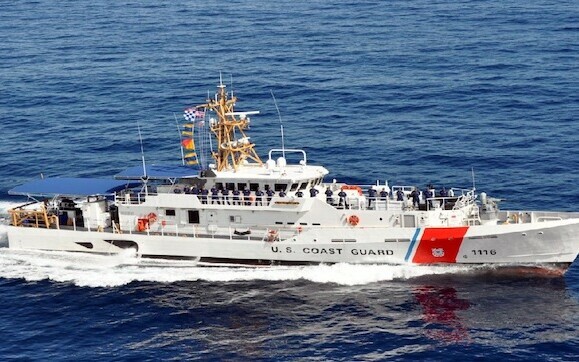Accident reports are intended to be exercises in accountability and to offer so-called lessons learned that will reduce the likelihood of repeat performances.
Often, they raise doubts. So, it is with the findings in the wake of the tragic accident off Puerto Rico last year in which a Coast Guard cutter ran down a 23' center-console fishing vessel.
The owner of the vessel survived, with serious injuries. The other fisherman, who was his brother, was killed.
Although the weather was clear and the accident took place in daylight, sea conditions were not ideal. The forecast called for 15 to 20 knots of easterly wind and four to six-foot seas, with occasional eight-foot seas.
A photo taken from a camera mounted high on the cutter Winslow Griesser suggests the forecasters got it right. It also underlines the difficulty of spotting small boats from larger ones. The center-console boat, the Desakata, would have been hard to pick up amid the whitecaps and blocked from vision when it was in the trough. And from the trough, the two fishermen may not have had the slightest inkling that a 154' cutter was bearing down on them.
Even if they had seen the cutter, its direction of travel may not have been apparent. According to the National Transportation Safety Board’s findings, the camera showed the cutter yawing in a following sea. Its bow would have been slicing between port and starboard as the seas shoved the stern in one direction, then another.
The Desakata was headed north, the cutter was more or less westbound. The Coast Guard describes the fishing boat as the “give-way” vessel. This would normally be the case, but the waters are muddied. The fishermen may have glimpsed the cutter and believed it was no factor based on its observed heading. Additionally, the Desakata was engaged in fishing, with four lines out. The crew may have believed — erroneously, since they were trolling — that the give-way burden applied to the cutter. In any event, there’s no record of the Desakata displaying a day shape to indicate it was indeed fishing. How would the cutter have known?
Ultimately, the name of the game is see and avoid. The notion of a privileged vessel goes only so far. It does not relieve the Coast Guard — or anyone else — of the duty to avoid collision. Unfortunately, no one knew a collision was imminent.
On the cutter’s mess deck, below the bridge, crewmembers “felt a shudder and heard a bang,” the NTSB said. The Desakata was in two pieces. From the agency’s report, it appears that Coast Guardsmen on the bridge were engaged in several tasks, none of which included looking out the windows.
Investigators were hindered by the refusal of the cutter’s captain, officer of the deck, and quartermaster of the watch to be interviewed, based on advice of their counsel.
This is sad commentary. It is legitimate (if sometimes dubious) to cite Constitutional protections to avoid jeopardy for criminal enterprise. Using the Constitution to avoid accountability in a fatal accident at sea when one’s job description can be boiled down to saving lives at sea verges on outrageous.
The Coast Guard’s final report found that the Desakata “failed to maintain a proper lookout.” This seems harsh, especially when one considers that the cutter was making 29 knots. Even if two men in a small open boat aren’t systematically scanning the horizon, they are going to have a threshold level of awareness of what’s going on around them. Had the weather been better, or the cutter traveling slower, it’s likely the fishermen would have seen it.
By no means did the Coast Guard report spare the Winslow Griesser’s crew. The captain was suspended and eventually lost his command. In its final report, the Coast Guard fell on its sword, conceding that the Winslow Griesser did not live up to the public’s rightful expectations, “with tragic consequences for members of the public we serve,” as Vice Adm. Kevin E. Lunday wrote. “We will do better.”
In the wake of the accident, the NTSB suggested, among other things, the installation of voyage data recorders aboard Coast Guard cutters and equipping small boats, such as the Desakata, with radar reflectors or class B or B+ AIS. The latter suggestion is likely to meet resistance, if for no other reasons than cost.




